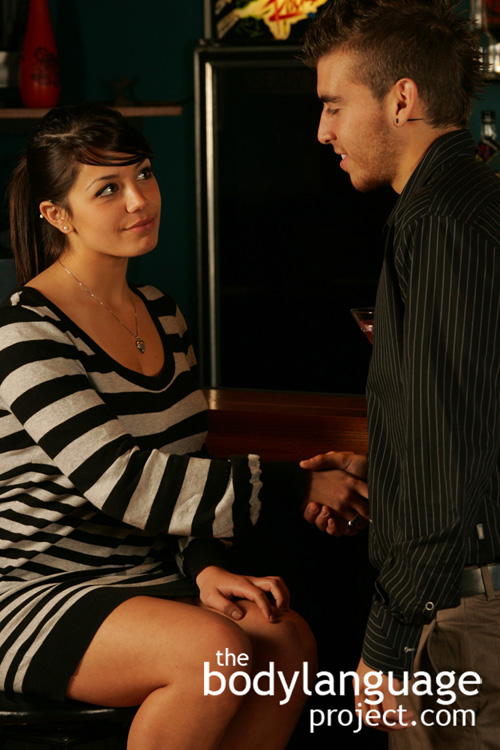Body Language of The Wrist Hold Handshake and The Upper Arm Grip Handshake
 Cue: Wrist Hold Handshake and Upper Arm Grip Handshake
Cue: Wrist Hold Handshake and Upper Arm Grip Handshake
Synonym(s): Upper Arm Grip Handshake, Handshake With Arm Clasp.
Description: a) The wrist of the other person is grasped with the left hand during an otherwise normal handshake. b) A political-type handshake that is normal except that the opposite hand reaches up to grasp the upper left arm just above the elbow or even the shoulder.
In One Sentence: The wrist hold handshake is a political handshake which aims to build strong bonds and alliances.
How To Use it: Use wrist hold handshake only if you are a high powered position on other high powered individuals. Others will be taken by surprise. When done properly, you can create a more intimate impression.
Context: Business.
Verbal Translation: “I’m shaking your hand while holding your wrist to show my desire for a close and more intimate connection with additional control in a business relationship.”
Variant: See Country Handshake (The), Cold Dead Wet Fish Handshake, Double Gripper Politician Handshake or Double Hander (The), Short Grabber/Finger Grabber Handshake, Oddball Handshake, Palm Up, Palm Down and Palm Even Handshakes, Stiff Arm And Thrust Forward Handshake, Death Grip Handshake, Wrench Forward Handshake, Undershaker Handshake, Wrist Hold Handshake, Wrist Hold Handshake and Upper Arm Grip Handshake, Limp Fish Handshake, Teacup Handshake, Arm Twister Handshake (The), Firm handshake, Fist Bumping.
Cue In Action: When the leader of two countries met, one president shook hands while grabbing the other’s wrist, and the other president grasped his shoulder. Each expressed a higher level of intimacy than just a handshake on its own.
Meaning and/or Motivation: Both the wrist hold handshake and the upper arm grip handshake is more common for politicians than ordinary people.
It is designed to build more intimacy and show desire to care, but also control. It is therefore much more powerful than an ordinary handshake. Its aim is to build strong bonds and build strategic alliances between high powered individuals.
In the wrong context, these handshakes will seem insincere and off-putting so they should only be used with extreme caution and in the right context.
Cue Cluster: Expect to see plenty of dominance cues such as arms akimbo, military man stance, chin up, palm displays, controlled gesticulation and facial expressions, dominant eye contact, upright postures and puffed out chests.
Body Language Category: Aggressive body language, Authoritative body language, Confident body language, Dominant body language, Friendship touching or friendly touching, High confidence body language, High confidence hand displays, Leadership body language, Remotivating gesture, Social touching.
Resources:
Aström, J ; Thorell, L H ; Holmlund, U ; D’Elia, G. Handshaking, personality, and psychopathology in psychiatric patients, a reliability and correlational study. Perceptual and motor skills 1993, Vol.77(3 Pt 2): 1171-86.
Bohm. 1997. Effects of interpersonal touch, degree of justification, and sex of participant on compliance with a request. The Journal of social psychology. 137: 460-469.
Chaplin William F.; Phillips Jeffrey B; Brown Jonathan D.; Clanton Nancy R.; Stein Jennifer L.; 2000. Handshaking, gender, personality, and first impressions Journal of personality and social psychology. 79(1): 110-117.
Fisher, J; Rytting, M and Heslin, R. 1976. Hands touching hands: affective and evaluative effects on interpersonal touch, Sociometry 39: 416–421.
Fromme, Donald ; Jaynes, William ; Taylor, Deborah ; Hanold, Elaine ; Daniell, Jennifer ; Rountree, J. ; Fromme, Marie. Nonverbal behavior and attitudes toward touch. Journal of Nonverbal Behavior. 1989. 13(1): 3-14.
Floyd, Kory. All Touches are not Created Equal: Effects of Form and Duration on Observers’ Interpretations of an Embrace. Journal of Nonverbal Behavior. 1999. 23(4): 283-299.
Fisher, J; Rytting, M and Heslin, R. 1976. Hands touching hands: affective and evaluative effects on interpersonal touch, Sociometry 39: 416–421.
Frumin, Idan; Ofer Perl; Yaara Endevelt-Shapira; Ami Eisen; Neetai Eshel; Iris Heller; Maya Shemesh; Aharon Ravia; Lee Sela; Anat Arzi and Noam Sobel. A Social Chemosignaling Function for Human Handshaking. eLife 2015. 4:e05154
http://bodylanguageproject.com/articles/shake-hands-share-human-scent-curious-case-hand-sniffing-body-language/
Gurevitch, Z. D. The Embrace: On the Element of Non-Distance in Human Relations. The Sociological Quarterly. 1990. 31(2): 187-201.
Dolcos, Sanda ; Sung, Keen ; Argo, Jennifer J ; Flor-Henry, Sophie ; Dolcos, Florin. The power of a handshake: neural correlates of evaluative judgments in observed social interactions. Journal of cognitive neuroscience. 2012 24(12): 2292-305.
Greenbaum, Paul ; Rosenfeld, Howard. Varieties of touching in greetings: Sequential structure and sex-related differences. Journal of Nonverbal Behavior. 1980. 5(1): 13-25.
Guéguen, N. (2007). Courtship compliance: The effect of touch on women’s behavior. Social Influence, 2, 81-97.
Guéguen, Nicolas. Nonverbal encouragement of participation in a course: the effect of touching Social Psychology of Education. 2004. 7: 89–98.
http://bodylanguageproject.com/articles/a-touching-way-to-encourage/
Gueguen, Nicolas. Handshaking and Compliance With a Request – A Door-to-door Setting. Social Behavior and Personality. 2013. 41(10): 1585-1588.
http://bodylanguageproject.com/articles/handshakes-lead-compliance-study/
Hiemstra, Kathleen M. Shake My Hand: Making the Right First Impression in Business With Nonverbal Communications.(Brief Article)(Statistical Data Included). Business Communication Quarterly. 1999. 62(4): 71.
Larsen, Knuds. ; Leroux, Jeff. A study of same sex touching attitudes: Scale development and personality predictors. Journal of Sex Research. 1984. 20(3): 264-278.
Maclaren, Kym. Touching matters: Embodiments of intimacy. Emotion, Space and Society. 2014. 13: 95-102.
Mehrabian, Albert Holzberg, Jules D. (editor). Inference of Attitudes From the Posture, Orientation and Distance of a Communicator. Journal of Consulting and Clinical Psychology. 1968. 32(3): 296-308.
Mehrabian, Albert Deese, James (editor). Significance of posture and position in the communication of attitude and status relationships. Psychological Bulletin. 1969. 71(5): 359-372.
Paulsell, Shari ; Goldman, Morton. The Effect of Touching Different Body Areas on Prosocial Behavior. The Journal of Social Psychology. 1984. 122(2): 269-273.
Pease, Barbara and Allan Pease. 2006. The Definitive Book of Body Language Hardcover. Bantam.
Remland, M. S. and T. S. Jones 1995. Interpersonal Distance, Body Orientation, and Touch: Effects of Culture, Gender, and Age. Journal of Social Psychology 135(3): 281-297.
Rabinowitz, Fredric E. The male-to-male embrace: breaking the touch taboo in a men’s therapy group. Journal of Counseling and Development. 1991. 69(6): 574(3).
Sanda Dolcos; Keen Sung; Jennifer J. Argo; Sophie Flor-Henry and Florin Dolcos. The Power of a Handshake: Neural Correlates of Evaluative Judgments in Observed Social Interactions. Journal of Cognitive Neuroscience. 24; 12: 2292–2305.
http://bodylanguageproject.com/articles/handshake-open-body-language-powerful-nonverbal-effect-brain/
Stewart, Greg L. ; Dustin, Susan L. ; Barrick, Murray R. ; Darnold, Todd C. Zedeck, Sheldon (editor). Exploring the Handshake in Employment Interviews. Journal of Applied Psychology. 2008. 93(5): 1139-1146.
Spezialetti, Brian D. Do’s and don’ts for winning the job interview. (laboratory technicians). Medical Laboratory Observer. 1995. 27(7): 51-53.
Wesson, David A. The handshake as non-verbal communication in business. (marketing technique). Marketing Intelligence & Planning. 1992. 10(9): 61(6).
Willis, Frank N. , Jr. ; Dodds, Rebecca A. Age, relationship, and touch initiation. The Journal of Social Psychology. 1998. 138(1). 115(9).




